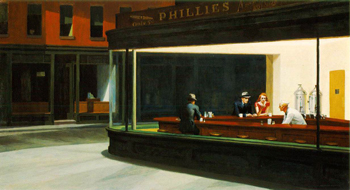| Search Art Prints | ||||||||||||||||||||
| Search Artists | ||||||||||||||||||||

|
||||||||||||||||||||
|
|
|||||||||||||||||||

Nighthawks

|
Nighthawks is Hopper's most famous image, one that has become an icon of Americana (it was copied, with different characters, for the kitschy pop-art painting Boulevard of Broken Dreams). He completed it in 1942, and it was actually given its name by his wife, Jo.
Three major influences that Hopper drew on in painting Nighthawks can be clearly discerned: Van Gogh's sinister Night Café (a similar scene and mood), gangster films of the 1930s (to which Nighthawks is stylistically, if not thematically, linked), and The Killers, a short story by Ernest Hemingway. The Killers, with its suspense of impending violence, has much in common with the ominous mood of Nighthawks, and Hopper highly praised the short story in correspondence at least once. The tension of The Killers is primarily what carried over into Nighthawks, which captures a vaguely malign, ambiguous moment.
The abnormally large restaurant is also particularly evocative. It accents the emptiness of the establishment; with more space around them, the people seem even more isolated than they would in a smaller, more cramped setting. Early sketches had the couple facing each other intimately, while in the final product, they are staring ahead, as if lost in separate reveries. The man on the left remains completely anonymous within the group, neither the couple nor the counterman paying him any mind. His indifferent posture further underscores this, while the counterman's upward gaze that seems disconnected and aimless. Hopper himself commented that he was probably unconsciously painting the loneliness of a city.











